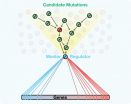Scientists reveal why beer tastes good to us and to flies
2014-10-09
(Press-News.org) Beer yeasts produce chemicals that mimic the aroma of fruits in order to attract flies that can transport the yeast cells to new niches, report scientists from VIB, KU Leuven and NERF in the reputed journal Cell Reports. Interestingly, these volatile compounds are also essential for the flavor of beverages such as beer and wine.
Kevin Verstrepen (VIB/KU Leuven): "The importance of yeast in beer brewing has long been underestimated. But recent research shows that the choice of a particular yeast strain or variety explains differences in taste between different beers and wines. In fact, yeasts may even be responsible for much of the "terroir", the connection between a particular growing area and wine flavor, which previously often was attributed to differences in the soil".
Yeast is essential in production of bread, beer and wine
Humans have been using yeast for thousands of years to produce bread, beer and wine. The reason for this is simple – the microbes eat sugars and convert them into carbon dioxide gas and alcohol. In bread, the gas causes leavening of the dough while the alcohol evaporates during baking. In beer and sparkling wines, both the alcohol and carbon dioxide gas are retained; whereas in wine the gas is allowed to escape.
However, the role of yeast cells is more complex than the conversion of sugars into alcohol and carbon dioxide. Yeast cells also produce several aroma compounds that are key for the taste, flavor and overall quality of beer and wine. In fact, different yeasts are producing different amounts of these aroma compounds. Whereas the importance of yeast aroma production is now fully appreciated, the reason why yeast cells would make these special, volatile chemicals remains mysterious. Surely, they don't do it to please humans....
Aroma compounds to attract flies
A new collaborative study led by scientists from VIB, KU Leuven and NERF shows that the fruity volatiles produced by yeast cells are highly appealing to fruit flies. This attraction allows some yeast cells to hitch a ride with the insects, who carry the otherwise immobile microbes to new food sources. Moreover, deleting ATF1, the key yeast gene driving aroma synthesis, all but abolishes the attraction of flies to the mutants. Moreover, the brain activity in flies that are exposed to such aroma-mutants is very different from that in flies exposed to normal, fruity yeasts.
"Flies are strongly attracted to normal yeast cells, when compared to mutant yeasts that don't produce esters. Knowing that esters make beer taste good, it seems that the same flavors that allow us to enjoy our beer, probably evolved to attract flies and to help yeast disperse into broader ecosystems" says Emre Yaksi (NERF – VIB/KU Leuven), the neuroscientist who led the experiments on flies. Bassem Hassan (VIB/KU Leuven): "This ground-breaking study was only possible because we were able to combine the know-how of different research groups, with expertises ranging from yeast genetics to animal behavior and neurobiology. It was quite fun to learn from each other".
Far-reaching implications
The team believes that their findings have far-reaching implications. "We all know that flowers attract insects by producing aromas. But there's also a lot of microbes living inside flowers, and the chemicals they produce may also play an important role" says Joaquin Christiaens (VIB/KU Leuven), who performed the experiments with yeast cells. Luis Franco (NERF - VIB/KU Leuven), who performed the fly assays, agrees "There's a lot to be learnt about the mutualism between insects and microbes, and some of what we find may have implications in agriculture and medicine. Don't forget that insects also carry disease-causing microbes..."
INFORMATION:
ELSE PRESS RELEASES FROM THIS DATE:
2014-10-09
A key mechanism behind diabetes may start in the brain, with early signs of the disease detectable through rising levels of molecules not previously linked to insulin signaling, according to a study led by researchers at the Icahn School of Medicine at Mount Sinai published today in the journal Cell Metabolism.
Past studies had found that levels of a key set of protein building blocks, branched-chain amino acids (BCAAs), are higher in obese and diabetic patient, and that this rise occurs many years before someone develops diabetes. Why and how BCAA breakdown may be ...
2014-10-09
NEW YORK, NY (October 9, 2014)—Using an innovative algorithm that analyzes gene regulatory and signaling networks, Columbia University Medical Center (CUMC) researchers have found that loss of a gene called KLHL9 is the driving force behind the most aggressive form of glioblastoma, the most common form of brain cancer. The CUMC team demonstrated in mice transplants that these tumors can be suppressed by reintroducing KLHL9 protein, offering a possible strategy for treating this lethal disease. The study was published today in the online issue of Cell.
The team used ...
2014-10-09
VIDEO:
Salk researchers explain how a new class of lipids may be tied to diabetes.
Click here for more information.
LA JOLLA—Scientists at the Salk Institute and Beth Israel Deaconess Medical Center (BIDMC) in Boston have discovered a new class of molecules—produced in human and mouse fat—that protects against diabetes.
The researchers found that giving this new fat, or lipid, to mice with the equivalent of type 2 diabetes lowered their elevated blood sugar, ...
2014-10-09
New Rochelle, NY, October 9, 2014—Excessive and often lethal blood levels of bilirubin can result from mutations in a single gene that are the cause of the metabolic disease known as Crigler-Najjar syndrome type 1 (CNS1). A new gene therapy approach to correcting this metabolic error achieved significant, long-lasting reductions in bilirubin levels in a mouse model of CNS1 and is described in an Open Access article in Human Gene Therapy, a peer-reviewed journal from Mary Ann Liebert, Inc., publishers. The article is available on the Human Gene Therapy website at http://online.liebertpub.com/doi/full/10.1089/hum.2013.233. ...
2014-10-09
TIFTON, GA – Weed control is one of the most challenging aspects of organic crop production. Most growers of certified organic crops rely heavily on proven cultural and mechanical weed control methods while limiting the use of approved herbicides. A new study of herbicides derived from clove oil tested the natural products' effectiveness in controlling weeds in Vidalia® sweet onion crops.
"Cultivation with a tine weeder and hand weeding are the primary tools currently used for weed control in organic sweet onion (Allium ceps)," explained scientist W. Carroll ...
2014-10-09
IZMIR, TURKEY – Tomatoes are known to be rich in antioxidants such as vitamin C, lycopene, β-carotene, and phenolics. Antioxidants, substances capable of delaying or inhibiting oxidation processes caused by free radicals, are of interest to consumers for their health-related contributions, and to plant breeders for their ability to provide plants with natural resistance to biotic and abiotic stresses. While tomato domestication and breeding programs have typically focused on traits such as fruit weight, color, shape, and disease resistance, scientists are now ...
2014-10-09
In an analysis of more than 8,000 episodes of Staphylococcus aureus bloodstream infections, there were no significant differences in the risk of death when comparing patients exhibiting less susceptibility to the antibiotic vancomycin to patients with more vancomycin susceptible strains of S. aureus, according to a study published in JAMA. The study is being released early online to coincide with the IDWeek 2014 meeting.
Staphylococcus aureus is among the most common causes of health care-associated infection throughout the world. It causes a wide range of infections, ...
2014-10-09
PHILADELPHIA – Hospitalized children go home sooner and are less likely to be readmitted when the hospital has an antibiotic stewardship program that's dedicated to controlling antibiotic prescriptions and treatment, according to a study being presented at IDWeek 2014™. The study is the first to show the benefits of such programs on children's health.
Antibiotic stewardship programs are increasingly being used to manage how and when antibiotics are being prescribed in hospitals and other health care facilities across the country. Often led by epidemiologists or ...
2014-10-09
An international team of chemists has discovered a new piece to the puzzle of how a powerful base used in organic synthesis, cesium carbonate, plays a pivotal role during a catalytic reaction.
The research, published by the Journal of the American Chemical Society, was led by Jamal Musaev, a theoretical chemist at Emory University, and Ken Itami, an experimental chemist from Nagoya University in Japan. Sun Yat-Sen University in Guangzhou, China, also contributed to the findings.
Many organic chemistry reactions are acid/base reactions, involving the exchange of positively ...
2014-10-09
NASA's Aqua satellite flew over Tropical Cyclone Hudhud on Oct. 9 and took a picture of the storm that showed it was still somewhat elongated, but more organized than the previous day. Another NASA satellite provided the hint of a developing eye. Warnings for winds, rain and surf are already in effect for the northern Andhra Pradesh coast and south Odisha coastline of eastern India as Hudhud approaches.
Tropical Cyclone Hudhud formed on Oct. 8 and began moving from east to west across the Bay of Bengal, Northern Indian Ocean.
On Oct. 9 at 07:45 UTC (3:45 a.m. EDT), ...
LAST 30 PRESS RELEASES:
[Press-News.org] Scientists reveal why beer tastes good to us and to flies




